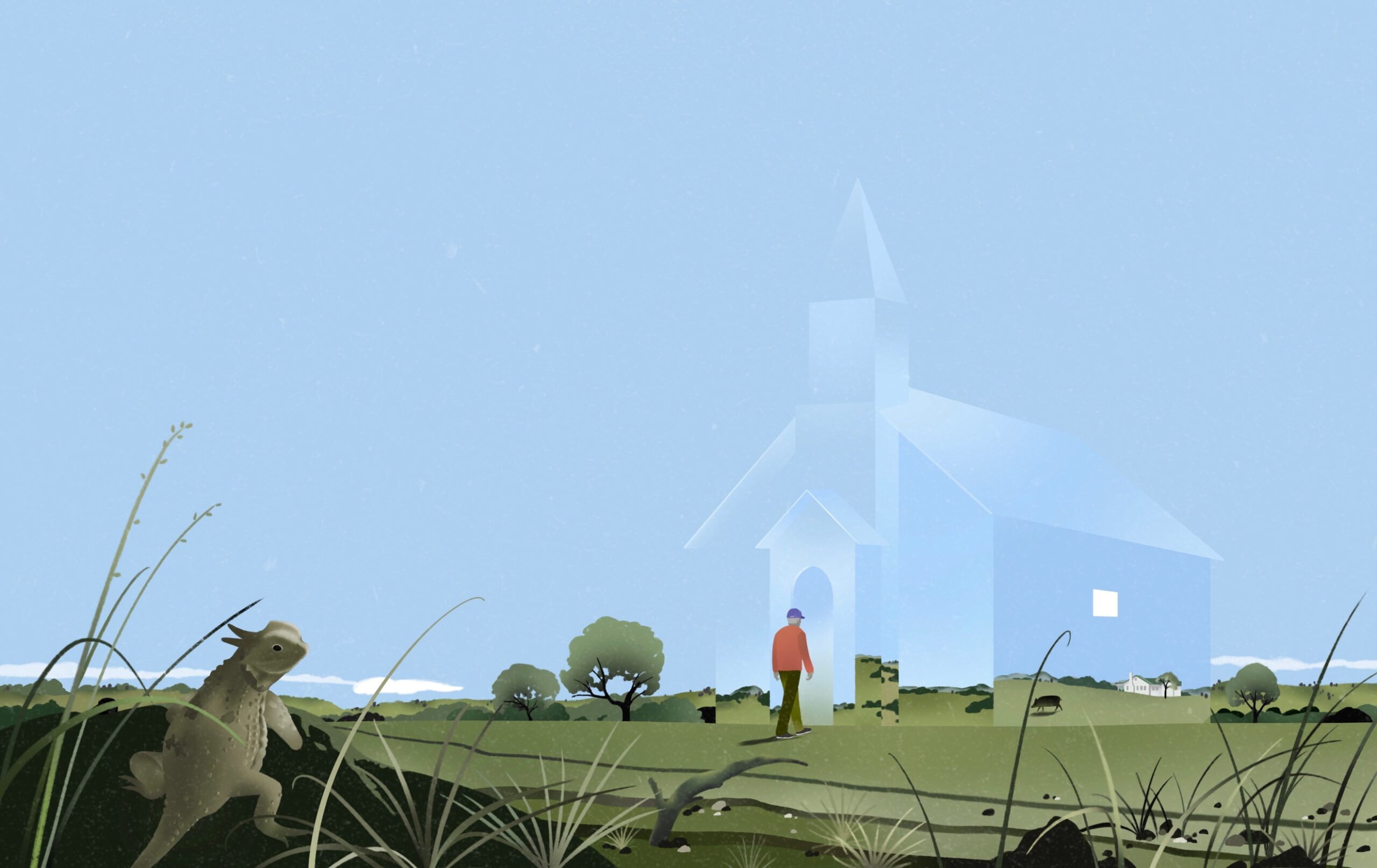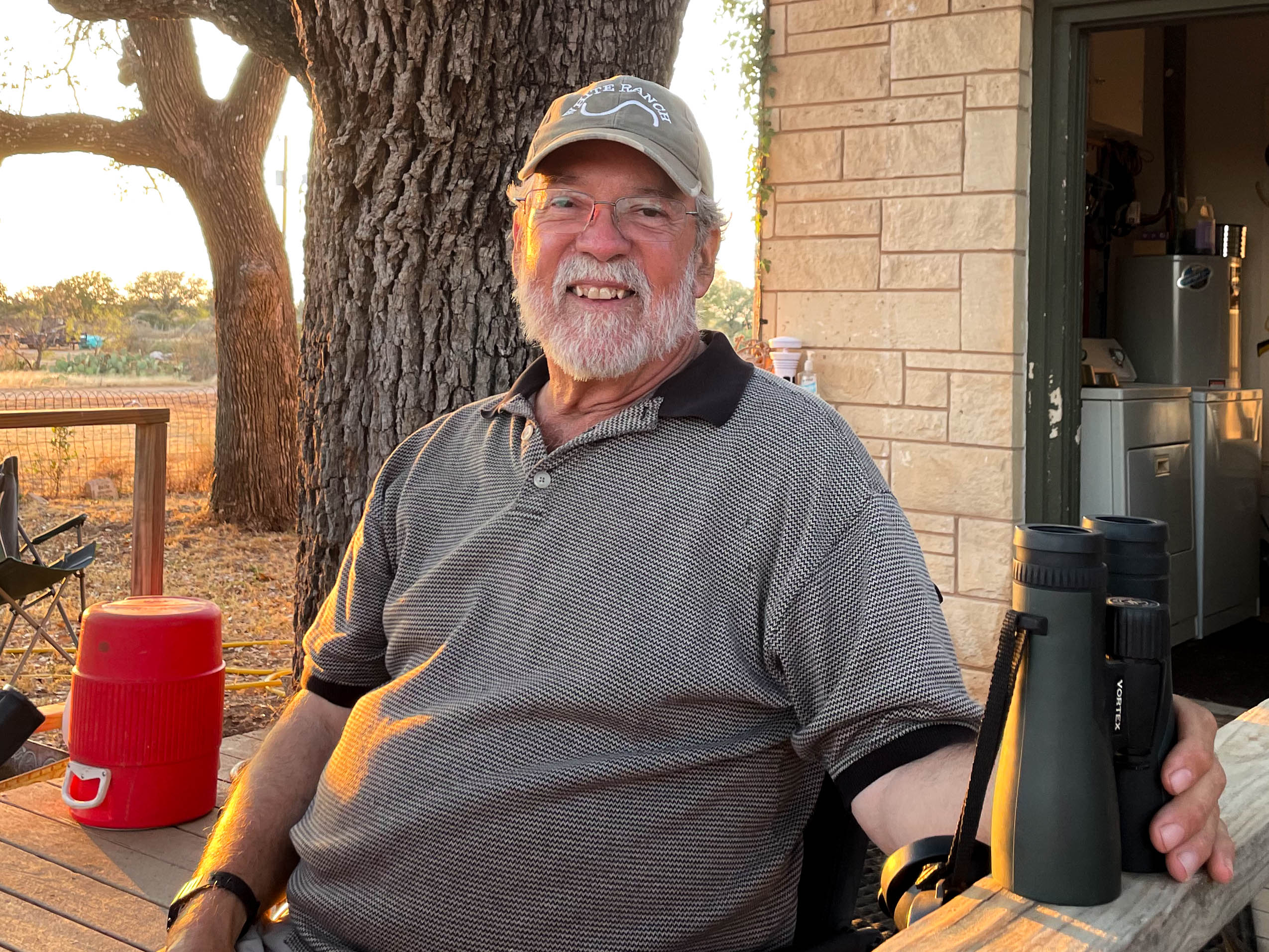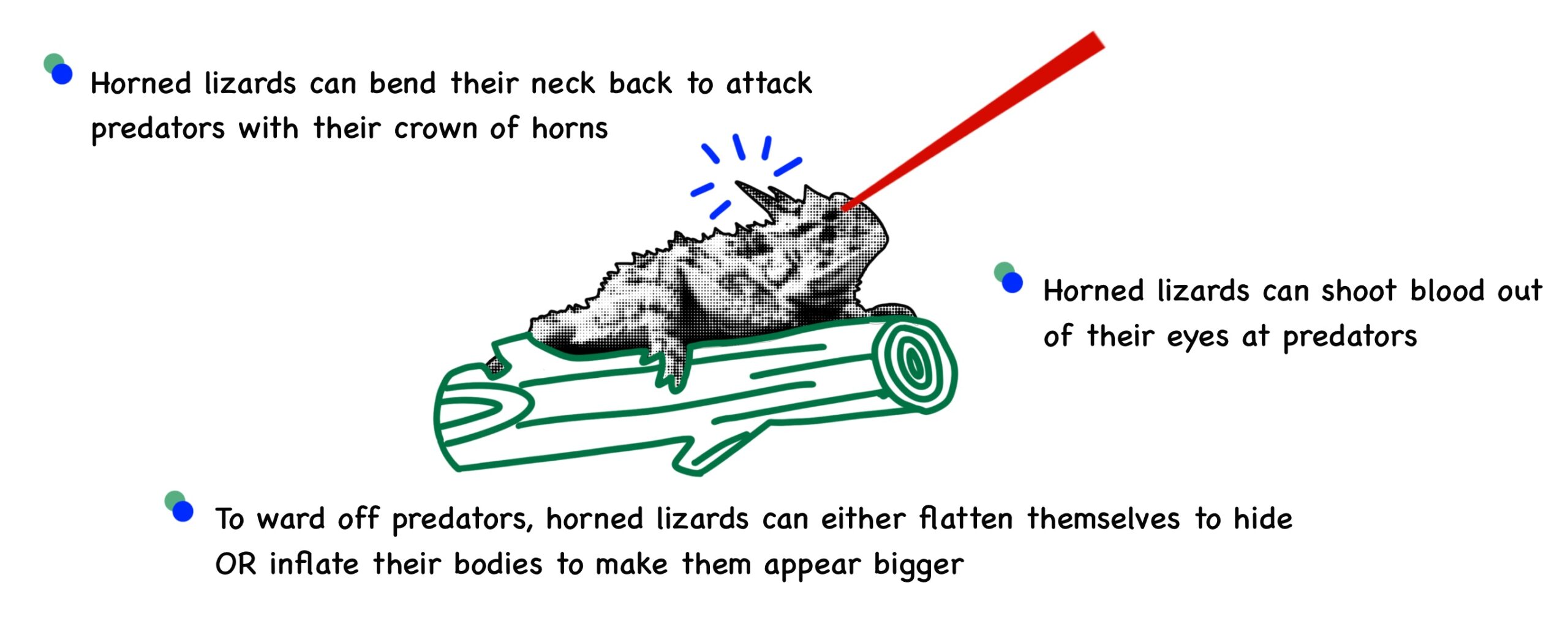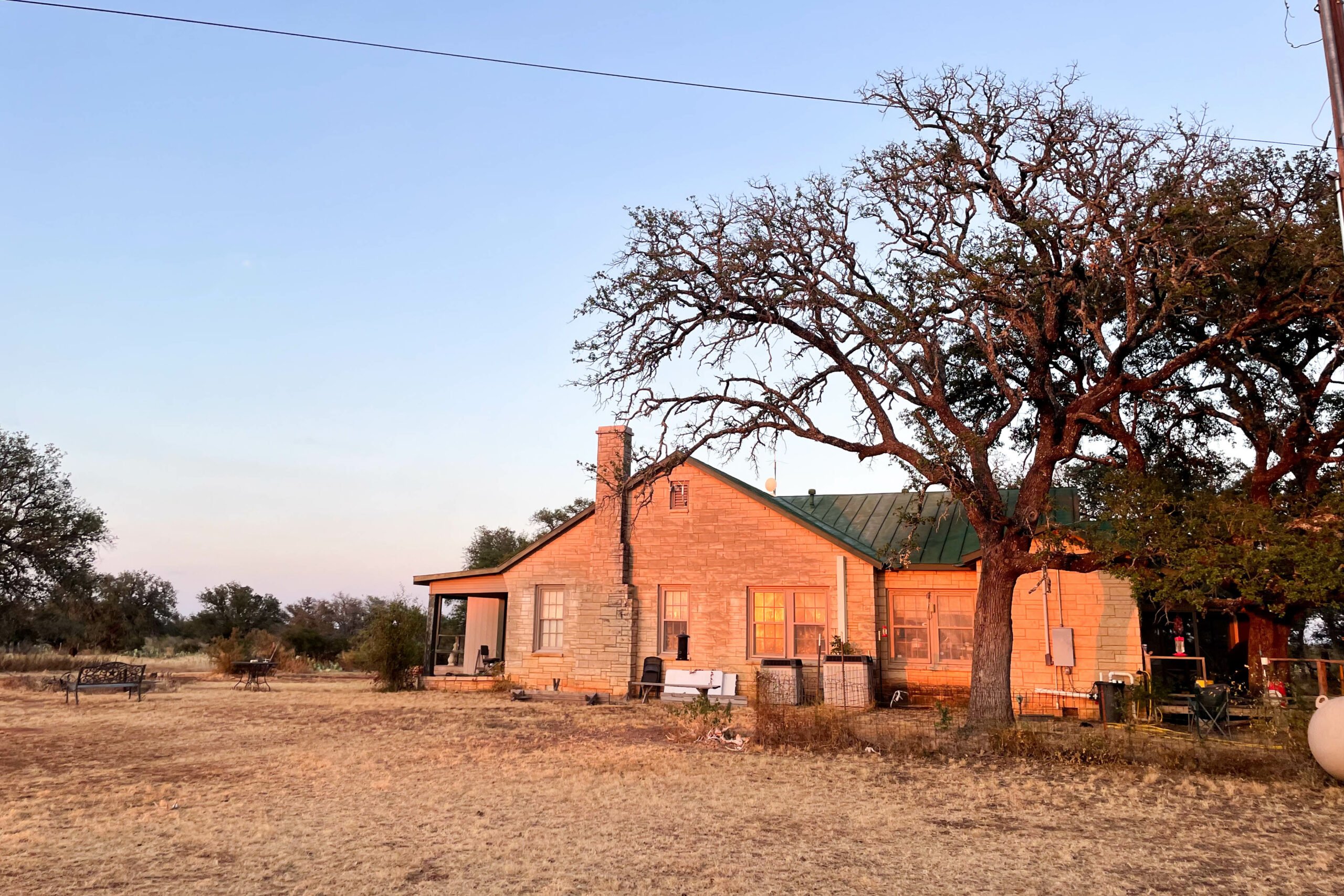
ARD SU / NEXTGENRADIO
What is the meaning of
home?
Jade Emerson speaks with Brian Wright, the manager of the 9,500-acre ranch in Mason, Texas. To Wright, home is something he shares with all the critters on the land, whether that’s cattle he’s grazing or the currently threatened Texas Horned Lizard. Wright is on a mission to combine ranching with conservation to sustain the ranch for everyone — and everything — that calls the land home.
Texas rancher creates sanctuary for threatened horned lizards
Listen to the story
Click here for audio transcript
(Slight sound of wind and feet crunching on dirt)
BRIAN WRIGHT:
I can’t believe that. Isn’t that the coolest thing?
(Sound of wind and the hum of the motor of a Kawasaki MULE)
I’m Brian Wright. I’m at White Ranch.
And we are currently just, I mean, literally right after the sun had gone down and it started to get a little bit dark and gray. We’re driving the roads in a Kawasaki MULE and actually found one of the sweethearts of the rodeo or one of the species that I love on this ranch, and it’s a little horned lizard with beautiful markings, all kinds of different colors, camouflaging and on its belly it has lots of different spots. So they’re just really unique little critters.
When you ask a question like, “How do I share my home with these critters?” I think it’s actually the opposite. They’re sharing their home with me.
(Sound of wind the hum of the motor fade out)
I work at White Ranch, which is a fifth generation ranch that in central Texas that is trying to survive and stay whole, like so many of the other ranches.
Gosh. I mean, how do you define rancher? It’s kinda like defining home. What is your home? What is a rancher? You know, in my case I do ride horses. I do help with cattle, sheep, and goats.
(Sound of a wild boar snorting)
You’re, anything from the sanitation engineer taking care of septic systems to electrical problems, or, you know, plumbing problems to fixing fences. I mean, it’s nonstop.
Yesterday when I woke up, the cattle were in the yard. Well, somebody had left a gate open, so I had to go take the cattle back to where they were supposed to be.
I always liken White Ranch and what I do here as being a 13,000 piece puzzle, jigsaw puzzle, and I’ve got about three pieces in place. I mean, it’s gonna be a challenge, and it has been a challenge, but we know we’re, we’re headed in the right direction,
That’s part of what I’m trying to do is make the ranch sustainable. And by doing that, you need to really take care of your resources. You want to try to find that good balance. And mother nature is going to dictate what that balance is.
So Texas Horned Lizards the way that we, uh, started getting interested in them, or I did, I, I got so excited. I knew Horned Lizards from San Antonio from 50 years ago. So, but they kind of went away. As more development came in, uh, the horn lizards went away, so, you know, we lost them.
Urban sprawl is probably one of the hardest things on horned lizards. They starved to death more or less. So when I came out here is when I first saw my first horned lizard.
And they have a mystique about ’em, you know. They’re, they’re kind of so ugly, they’re cute.
(sound of an engine accelerating and changing gear)
What we’re gonna be looking for as we’re driving along is if you see any motion or if you see something that looks out of place.
So it looks like a pancake moving across the ground, kind of. Actually, a flat football moving across the ground with horns and scales.
As I started seeing one and started seeing two and 10. Then I started realizing that this was someplace special
(Sound of chain hitting a gate)
The definition of a church is a, is a building that people go and, and congregate together and, and worship.
And for me, it’s every time I go out and drive around.
(Sound of an engine accelerating)
I mean, this is my house of worship. Talk about home? This is home.
(Sound of engine fades out)
Brian Wright savors his evening drives on the White Ranch in Mason, Texas. He lives and works on the 9,500-acre property as the ranch’s manager. The drive has become one of his rituals, because Wright considers nature to be his church.
“What is the definition of a church – it’s a building that people go and congregate together and worship,” says Wright, 69. “And for me, it’s every time I go out and drive around … I mean, this is my house of worship.”
On the side of the red-dirt road, a flash of movement catches his eye. He pulls over his ranch vehicle, a sage green Kawasaki Mule, and hurries to scoop up a small bundle of horns and scales. It’s a Texas Horned Lizard and it quickly flattens out like a pancake, to a size nearly as big as his hand. That’s just one of its defense mechanisms to hide from predators.
“They’re just unique little critters,” he says. “They will squirt blood out of their eyes when you start to handle ’em if they’re really fearful. So sometimes when I’ve picked ’em up, they’ve actually squirted blood on my hand or on my shirt.”
Wright flips the lizard over and points at the spots on its cream-colored stomach. He explains that the spots are kind of like a fingerprint.
To Wright, this lizard is the “sweetheart of the rodeo” — horns and all.
“They have a mystique about ’em, you know. They’re kind of so ugly, they’re cute,” he says.

Brian Wright holds a Texas Horned Lizard, a threatened species, in his hand which he caught on the side of the road at White Ranch in Mason, Texas on Sept. 4. Wright affectionately calls the lizards the “sweethearts of the rodeo.”
JADE EMERSON / NEXTGENRADIO
Facing a threat
Over the past 60 years, Texas Horned Lizards have been disappearing in many parts of the state. Insecticides have almost completely wiped out their food source of native ants, and invasive fire ants can kill the baby lizards. Horned lizards also face habitat loss from urban development.
Because over 93% of land in Texas is privately owned, it’s in large part up to those landowners — and the people like Wright who manage that land — to protect native species like these lizards.
But just as Texas horned lizards are disappearing, farms and ranch land are also facing a decline. Wright and the horned lizards are in a sort of last stand together.
“This used to be one of the largest ranches,” Wright says. “As the ranches get smaller, it’s hard to earn more income off the ranches. It’s almost impossible for somebody to go out nowadays and actually buy ranch property and make a living off of it.”
Wright remembers the first time he saw one of the lizards on the White Ranch. He was driving with the former ranch owner when he noticed it on the side of the road. Wright said he realized he hadn’t seen one since his childhood in San Antonio.
“As I started seeing one and started seeing two and 10, then I started realizing that this was someplace special,” Wright says.
“I always liken White Ranch and what I do here as being a 13,000-piece jigsaw puzzle, and I’ve got about three pieces in place. It’s gonna be a challenge, and it has been a challenge, but we know we’re headed in the right direction.”

Ranch manager Brian Wright sits on the porch of his home wearing a White Ranch baseball cap with a pair of binoculars on Sept. 4. He spends his free time watching deer and other native critters he shares his home with. Jade Emerson/NextGen Radio.
JADE EMERSON / NEXTGENRADIO
A lifetime of loving nature
Wright grew up taking trips to state parks all across Texas with his mom and two siblings. She was a schoolteacher and a single parent. Through these trips, Wright said his mom instilled in him a love for nature through these trips
“She could turn us loose and let us run around and be heathens and renegades and we’d go on hikes together,” he says. “And so she was really the one that introduced us to nature.”
After spending two years at a junior college, Wright spent 15 years working for IBM and then as a handyman in San Antonio. But, he says that every chance he got, he’d visit different ranches in Texas to hunt and explore nature.
In 2014, he decided he wanted to return to the outdoors and work at a ranch. A mutual connection helped Wright find work at White Ranch as the ranch’s manager and caretaker of the former owner.
Turning passion into profit
After Wright saw that first horned lizard on the ranch, he changed his approach to his job.
“I think the conservation side of things has always been in me and the horned lizards, being the sweetheart of the rodeo, brings to light that,” he said. “What can we do to help promote them?”
In 2018, Wright began to collaborate with Texas Parks and Wildlife to improve the lizards’ habitat. Grant money for the efforts covers 30-70% of the costs of projects at the ranch aimed at sustaining the land.
Part of that sustainability includes prescribed burning, a process where a heavily monitored fire is started to clear out brush and improve soil conditions.
“[It is] one of the most efficient, effective, and cost effective ways of managing brush and taking the landscape back to grasses and lower shrub,” he says.
Wright has also opened up White Ranch to researchers at Texas Christian University’s Horny Toad Project in 2019. On certain parts of the ranch, small pink flags mark nesting sites.
“They actually put up a game camera focused right at the nest, hoping that they can get a picture or video of the babies as they emerge from underneath the soil after being there for 45 days,” Wright says.

ARD SU / NEXTGENRADIO
Instead of viewing conservation and ranching as different endeavors, Wright views them as one in the same. The White Ranch is still a fully operating cattle ranch and home to many different native animals like deer, jack rabbits and quail. But Wright has learned how to manage the livestock and at the same time, use the land to create a better habitat for the lizards.
“That’s part of what I’m trying to do is make the ranch sustainable. And by doing that, you need to really take care of your resources,” he says. “You don’t want to overstock your deer, nor do you want to overstock your cattle. You want to try to find that good balance and Mother Nature is going to dictate what that balance is.”
Wright feels a responsibility to carry on the historic legacy of the White Ranch, which was founded in 1888 and has seen five generations of ranchers.
“I think everybody worries about their mortality,” he says. “I would love to leave the ranch in better shape than when I got here. And I feel like I’m doing that. And part of that is to help make it better for the next generation.”
Wright says that Texas horned lizards have inspired the improvements he has made to make the ranch a sanctuary for all creatures, for generations to come.
“How do I share my home with these critters? I think it’s actually the opposite. They’re sharing their home with me,” he says. “I feel honored to even be here.”

Brian Wright embraces his dog while out on an evening drive at White Ranch in Mason, Texas on Sept. 4. His dog joins him on almost all of his evening drives around the ranch.
JADE EMERSON / NEXTGENRADIO

The setting sun casts light on Brian Wright’s home on the 9,500-acre White Ranch in Mason, Texas on Sept. 4. Wright shares the land with the cattle he manages, along with native animals including the Texas Horned Lizards.
JADE EMERSON / NEXTGENRADIO
